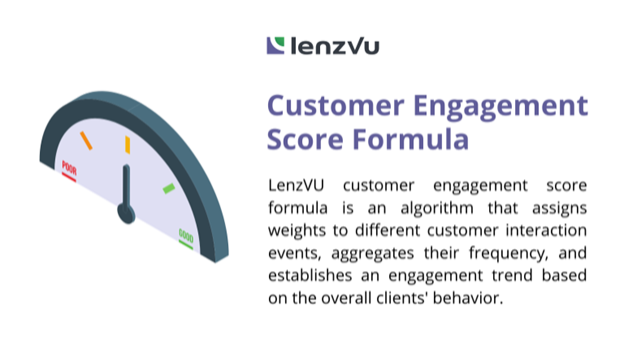How To Calculate a Customer Engagement Score
Customer engagement is a continuous process of interacting and communicating with your customers through interaction points such as emails and text messages. Any way that your target members can receive your messages or enjoy your services is an interaction point.
What is a Customer Engagement Score?
A customer engagement score—or CES—measures the extent to which your members engage with your business. A positive score means the customer is using your service and interacting with your business.
A negative score signifies an area of opportunity for your business to interact with a customer or group
of customers with intention to understand their lack of engagement.
Looking to improve your studio’s retention strategies? Our fitness business management software provides tools to analyze customer engagement and take action.
How to Track Your Studio’s Customer Engagement Score
Tracking your fitness studio’s CES is paramount to understand how well your business is engaging customers. Technology providers like Xplor Mariana Tek’s partner, LenzVU, can help make this quick and easy!

LenzVU calculates its customer engagement score based on the following metrics:
- Client website visits
- Physical location visits
- Phone calls and interactions
- Text Messages and interactions
- Email open and clicks
- Activities on other platforms (MindBody, Mariana Tek, FitDegree, etc.).
The LenzVU algorithm works by:
- Aggregating the number of engagement actions a user performs over a specified period;
- Weighing an interaction to correspond to the value it delivers to the business. For instance, checking in for a workout session does not carry the same engagement weight as opening a promotional or informational email;
- Providing an engagement score depending on the number of interaction points your business has with clients; and
- Establishing a trend by looking at historical behavior patterns showing whether the engagement is constant, increasing, or declining over time.
According to Afi Aflatooni, CEO of Tribute Kiosk, the company that owns LenzVU,
“We trend the score against a customer’s historical behavioral patterns, allowing a business to understand if there is a change in customer engagement. For example, suppose a customer has a CES of 154, but with a downward trend of 64%, the business should investigate the drop before the client terminates their subscription.”
Customer Engagement Score Example
LenzVU customer engagement score formula is an algorithm that assigns weights to different customer interaction events, aggregates their frequency, and establishes an engagement trend based on the overall clients’ behavior.

The tool presents a score and a percentage indicating the clients’ overall engagement trend. LenzVU computes the trend percentage by comparing the client’s present engagement against patterns over the past three months.
5 Ways to Use Customer Engagement Score for Client Retention
Client retention is the capacity of a business to maintain clients over time. Data shows that gaining new clients is up to five times more expensive than the cost of retaining existing ones, and increasing customer retention by just 5% can increase profits by up to 95%.
Using customer engagement scores, you can segment your clients and develop a customized retention plan for each. For instance, you may opt to segment your clients’ scores as follows:
- 80 -100% – High engagement
- 40 -80% – Medium engagement
- 0 – 40%- Low engagement
High-engagement clients with an upward trend are fully engaged and are effectively using your service. By leveraging this data, you can focus on clients that have a declining CES and implement strategies such as:
1. Develop a customer outreach schedule — Have a plan for communicating with your fitness studio clients to increase sales, solicit feedback, or re-engage with your clients. Especially for customers with medium and low engagement scores, be sure to implement their feedback judiciously. Make your clients understand you care about their goals when joining your facility and want to work with them to achieve them.
Reaching out to low-engagement clients will help you understand their reason for not interacting or using your service and allow you to make meaningful connections. For instance, a client can have a low engagement rate because they used to attend their session with a friend who is no longer coming.
What’s the opportunity to make a meaningful connection in such a situation? If your facility is a boutique studio, you could have the instructor in their next class give extra motivation and attention. With this, your client will see that you care about their well-being and the value of signing up for a membership at your studio.
2. Rewards and loyalty programs boost engagement — Consider implementing robust customer loyalty and rewards initiatives. For instance, you may give customers rewards for number of classes attended, participation in events or meeting goals they set with you.
3. Design personalized offers and packages in response to client needs — Remember, 80% of clients are more likely to do business with companies that offer personalized services. Consider amending packages to suit client lifestyles and preferences, especially for those whose declining engagement is due to irregular attendance due to conflicting schedules.
4. Have interactive content that educates your audience — Customer-centric interactive content like quizzes, image sliders, games, or interactive webinars will boost customer engagement. Interactive content not only has a higher engagement rate but is also known to deliver high conversion rates.
5. Build a community to enhance customer retention and experience — Establishing a community around your brand will build lasting relationships with your clients and enhance customer loyalty. Create unique experiences for your clients to engage with your studio outside of class. For example, you could offer a wine or beer social after an evening class or host a meet &greet event for clients to meet each other.
Frequently Asked Questions on Customer Engagement Scores
How do you calculate customer engagement rate?
LenzVU’s proprietary algorithm calculates customer engagement by weighing and aggregating the number and frequency of customer interactions with a business.The algorithm then computes a score and provides the percentage trend.
What is a good engagement score?
A good engagement score will vary according to the engagement strategy of a business.For example, a company might send out emails daily, while another only sends them monthly. Therefore a good client engagement score for the business with daily emails should be higher than the business that sends out monthly emails.
The other variable in determining a good engagement score is the client’s patterns which may not remain constant over a short time. For instance, a client might not open emails since they are super busy, while another might open and click on all the emails.
LenzVU’s customer engagement score provides trend analysis to help businesses understand a change in engagement patterns based on their client’s history. Trend analysis indicates the shifts in engagement behavior of a particular user and implements a retention strategy before members cancel their subscription. A client with over 70% upward trend pattern has a good engagement score.
Final Thoughts
LenzVU’s customer engagement score platform provides a score and a trend analysis showing the behavioral pattern of a client. The trend analysis puts the engagement score in perspective, helping you determine if the customer is fully engaged, will continue with your service, or is on the brink of canceling their subscription.
Our customer engagement score insights equip you with data-driven retention strategies, so you can target members with declining engagement trends. For a walk-through on how this platform can help you identify lower performing member scores, contact LenzVU today.
Want to improve client retention at your fitness studio? Discover how in-app features can make a difference in 4 Ways In-App Class Counts and Achievements Can Increase Customer Retention.
by Xplor Mariana Tek
-
First published: April 13 2023
Written by: Xplor Mariana Tek
